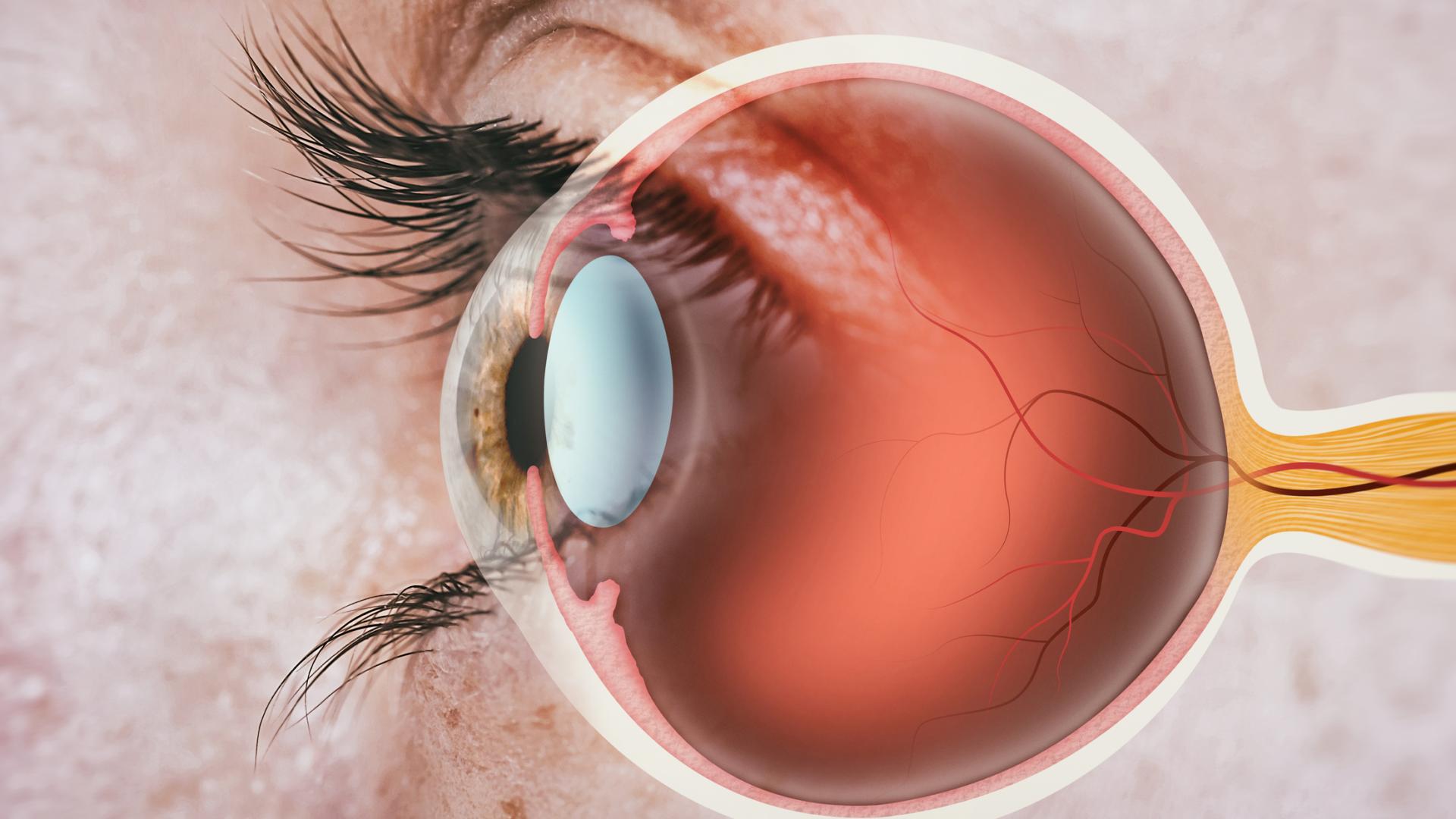
Several drugs have the potential to elevate eye pressure and increase the risk of developing glaucoma. This article explores the classes of medications that may affect the open-angle and angle-closure forms of glaucoma.
Important: Do not stop taking prescription medications without first consulting with your doctors.
Narrow Angles and Angle-Closure Glaucoma
Angle-closure glaucoma, the second most common type, is a largely inherited disorder caused by a too-narrow angle in the passageway where aqueous fluid would normally drain. This type of glaucoma may occur in two ways:
- The chronic type progresses slowly and, like open-angle glaucoma, can result in optic nerve damage. There are no symptoms until there is an apparent loss of peripheral vision. Treatment includes medication, laser therapy, and surgery.
- The acute (also called closed-angle) type begins suddenly when the normal flow of aqueous humor between the iris and lens is blocked. Symptoms include severe eye pain, nausea, vomiting, sudden onset of visual disturbance (often in low light), blurred vision, halos around lights, and reddening of the eye. This condition is a medical emergency and must be treated immediately. The initial treatment steps are to break the attack, which is accomplished using a combination of eye pressure-lowering medications and laser iridotomy. Without treatment, blindness can result in one or two days. If you do not have care established or access to an eye doctor, you should go to your nearest emergency room.
Most medications that could adversely affect glaucoma, or increase the chance of developing glaucoma, have the potential to narrow the drainage angle of your eye, called the trabecular meshwork. This would prevent eye fluid from exiting properly resulting in high eye pressure. The “angle” that is referred to is the angle between the iris, which makes up the colored part of your eye, and the cornea, which is the clear window front part of your eye.
If you have a known history of narrow angles or the condition known as angle-closure glaucoma, you should ask your ophthalmologist prior to using any medication that has a glaucoma warning. Your ophthalmologist will discuss the new medication with you and weigh the risks and benefits.
Factors That Increase Risk for Developing Medication-Induced Angle Closure
- Known pre-existing narrow angles
- Advanced age
- Female gender
- Hyperopia (farsightedness)
- Asian ethnicity
- Positive family history of angle-closure glaucoma
Medications to Discuss with Your Doctor if You Have Angle-Closure Glaucoma
Anticholinergics
Medications that have anticholinergic properties can adversely affect patients with narrow angles. Anticholinergic means that these drugs block the action of acetylcholine, a chemical messenger that transmits signals from one nerve cell to another nerve cell, muscle cell, or gland cell, for example.
Medications that have anticholinergic properties are used to treat the following medical conditions:
-
- Asthma and COPD Asthma and COPD (chronic obstructive pulmonary disease) medications include drugs such as Atrovent (ipratropium bromide) or Spiriva (tiotropium bromide), and may be associated with angle-closure glaucoma attacks.
- Incontinence and Overactive Bladder Medications This class of medications includes Detrol (tolterodine) and Ditropan (oxybutynin)
- Gastrointestinal Issues Medications such as Tagamet (cimetidine) and Zantac (ranitidine) are weak anticholinergics that may lead to angle-closure.
- Muscle Spasms Medications such as Norflex (orphenadrine) and Artane (trihexyphenidyl) have been associated with angle closure.
- Depression Many medications used for depression can have adverse effects in patients with narrow angles. These include selective serotonin reuptake inhibitors (SSRIs) such as Prozac (fluoxetine) and Paxil (paroxetine). Tricyclic antidepressants such as Elavil (amitriptyline) and Tofranil (imipramine) may also have some anticholinergic activity and thus should be used with caution in patients with narrow angles.
- Allergies Anti-allergy over-the-counter drugs that contain diphenhydramine put patients with narrow angles at risk.
- Nausea Some medications used to treat nausea have anticholinergic effects, such as Phenergan (promethazine).
- Anxiety One example is Vistaril (hydroxyzine), a medication that reduces anxiety, and can have strong anticholinergic effects, increasing the risk for angle closure.
Ephidrine-Containing Drugs
Ephedrine can result in acute angle-closure glaucoma attacks in patients with preexisting narrow angles.Some cold medications contain ephedrine for managing congestion.
Sulfonamide-Containing Drugs
Certain drugs can cause angle closure in some people, often in both eyes. This is because patients are likely to experience an allergic reaction to the sulfa drug. Examples of sulfonamide-containing drugs include Topamax (topiramate), Diamox (acetazolamide), Qualaquin (quinine), Sumycin (tetracycline), and Bactrim (trimethoprim/sulfamethoxazole).
Oral Steroids
Oral steroids can help to reduce inflammation and to reduce the activity of the immune system. This class of medication can affect eye pressure in people that have open-angle glaucoma, but can also raise eye pressure in those with the angle-closure form of the disease. See below for a list of some of the conditions that are treated using oral steroids.
Open-Angle Glaucoma
Primary open-angle glaucoma is the most common type of glaucoma and accounts for 70-90% of all cases. Often there are no noticeable symptoms at early stages.
This is a chronic, slowly progressing condition. Treatment for open-angle glaucoma includes medication, laser surgery, and incisional surgery.
Medications to Discuss with Your Doctor if You have Open-Angle Glaucoma
Oral Steroids
As mentioned above, oral steroids can help to reduce inflammation and to reduce the activity of the immune system. This class of medication is used for many conditions, including:
-
- Autoimmune diseases (lupus, autoimmune hepatitis)
- Inflammatory bowel diseases (Crohn’s disease, ulcerative colitis)
- Joint and muscle diseases (rheumatoid arthritis, polymyalgia rheumatic)
- Allergies and asthma
Short courses (1 to 2 weeks, for example) and lower doses of oral steroids decrease the risk of increased eye pressure. Other side effects in the eye, beyond increased pressure, include cataracts.
Not every person develops elevated eye pressures when taking oral steroids. Your risk is higher, however, if you have open-angle glaucoma, so if you are undergoing treatment for glaucoma and have recently been diagnosed with a condition that requires more chronic use of oral steroids, you should discuss this with your ophthalmologist. He or she may want to monitor you more closely while you are on steroid treatment. There are other forms of steroids, such as steroid creams, ointments, and inhaled steroids or nasal sprays that can also affect eye pressure. Please discuss if you are using these medications with your eye doctor. And, of course, topical steroid eye drops can increase eye pressure, but if you are using these medications, you should already be under the care of an eye care provider.
Talk to Your Doctor or Pharmacist
There are many other medications that can increase the risk of glaucoma in addition to the ones mentioned in this article, so it is always wise to talk with your pharmacist or your eye doctor about your medication regimen. Most pharmacies will give you the opportunity to speak with a pharmacist about your medications. You should mention that you have glaucoma and ask whether there are any potential issues. It is helpful to know if you have open angles or narrow angles, as most medications with glaucoma warnings are referring to the risk for people with narrow angles.
Most medications that can adversely affect glaucoma or put you at risk of developing glaucoma apply to persons who have narrow angles or angle-closure glaucoma. If you do not know your status, please consult with your eye doctor. If you do have narrow angles and must take medications that could cause further narrowing, a laser peripheral iridotomy is very helpful in preventing an acute angle-closure attack.
About BrightFocus Foundation
BrightFocus Foundation is a premier global nonprofit funder of research to defeat Alzheimer’s, macular degeneration, and glaucoma. Since its inception more than 50 years ago, BrightFocus and its flagship research programs—Alzheimer’s Disease Research, Macular Degeneration Research, and National Glaucoma Research—has awarded more than $300 million in research grants to scientists around the world, catalyzing thousands of scientific breakthroughs, life-enhancing treatments, and diagnostic tools. We also share the latest research findings, expert information, and resources to empower the millions impacted by these devastating diseases. Learn more at brightfocus.org.
Disclaimer: The information provided here is a public service of BrightFocus Foundation and is not intended to constitute medical advice. Please consult your physician for personalized medical, dietary, and/or exercise advice. Any medications or supplements should only be taken under medical supervision. BrightFocus Foundation does not endorse any medical products or therapies.
- Eye Health
- Lifestyle
- Medications









